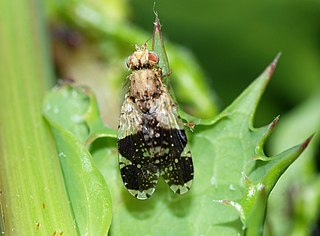Afraciura is a genus of tephritid or fruit flies in the family Tephritidae.
Cordylopteryx is a genus of tephritid or fruit flies in the family Tephritidae.
Actinoptera is a genus of tephritid or fruit flies in the family Tephritidae.
Clematochaeta is a genus of tephritid or fruit flies in the family Tephritidae.

Metasphenisca is a genus of fruit flies in the family Tephritidae. There are at least 25 described species in the Afrotropical and Oriental Regions. Of these, 20 occur in the continental Afrotropics and two are confined to Madagascar; three species occur in the Arabian Peninsula.
Oedaspis is a genus of tephritid or fruit flies in the family Tephritidae.
Platensina is a genus of tephritid or fruit flies in the family Tephritidae.
Scedella is a genus of tephritid or fruit flies in the family Tephritidae.

Tephritis is a genus of flies. It contains around 170 described species, making it the sixth largest genus in the family Tephritidae. Many more undescribed species are known from specimen collections. Tephritis occur throughout much of the world, but most are Palearctic. They can be found in a wide range of climate types, from hot semidesert to tundra. Most species inhabit the inflorescences of plants from several tribes in the family Asteraceae, and a few species cause galls to form.
Paraspheniscoides is a genus of tephritid or fruit flies in the family Tephritidae.
Rhabdochaeta is a genus of tephritid or fruit flies in the family Tephritidae.
Rhochmopterum is a genus of tephritid or fruit flies in the family Tephritidae.

Trupanea is a genus of tephritid or fruit flies in the family Tephritidae.
Gymnaciura is a genus of tephritid or fruit flies in the family Tephritidae.

Cecidocharini is a tribe of tephritid or fruit flies in the family Tephritidae.

Dithrycini is a tribe of tephritid or fruit flies in the family Tephritidae.
Dicheniotes distigma is a species of tephritid or fruit flies in the genus Dicheniotes of the family Tephritidae.
Antoxya oxynoides is a species of tephritid or fruit flies in the genus Antoxya of the family Tephritidae.
Argyrobrithes is a genus of flies in the family Stratiomyidae.




